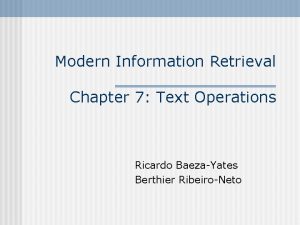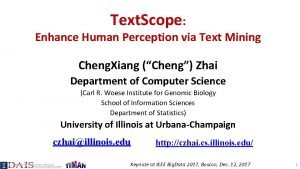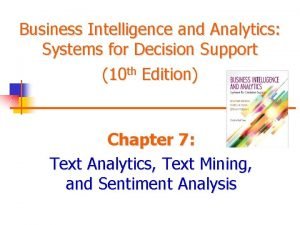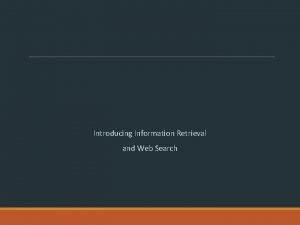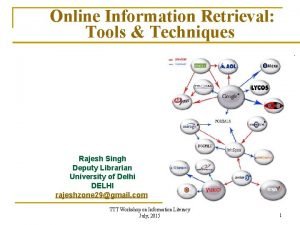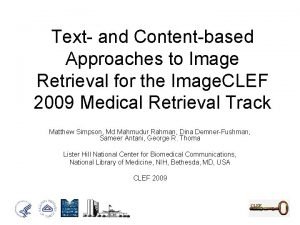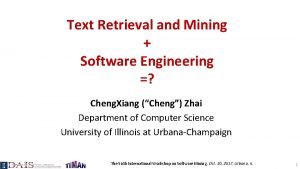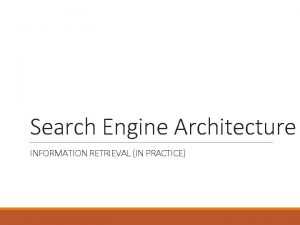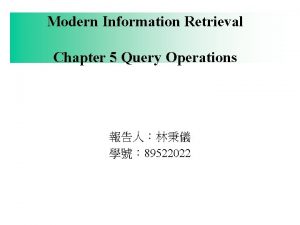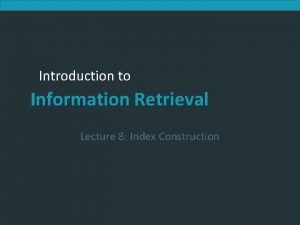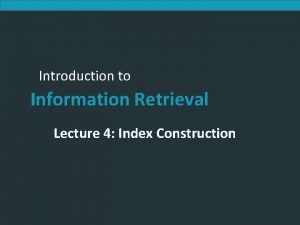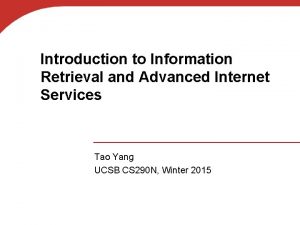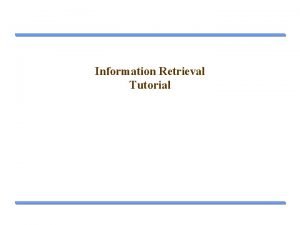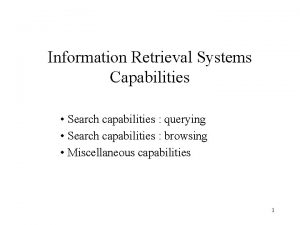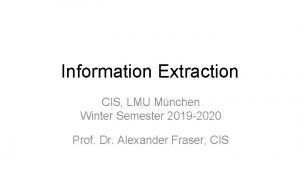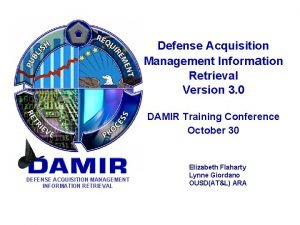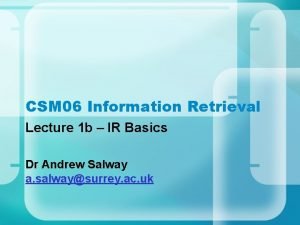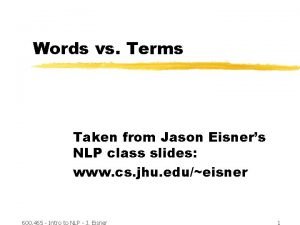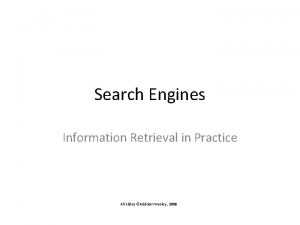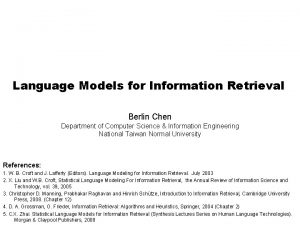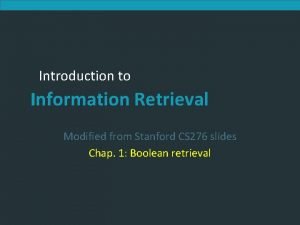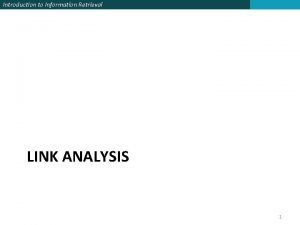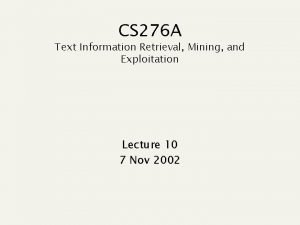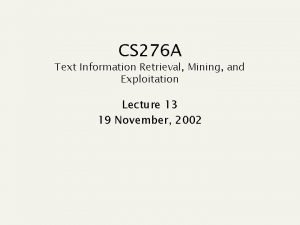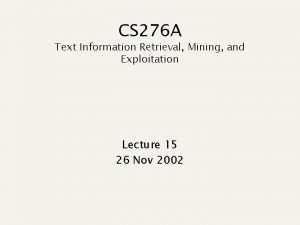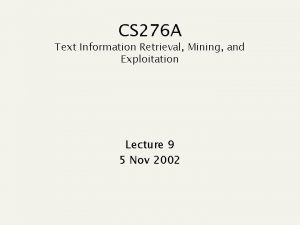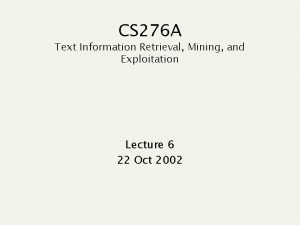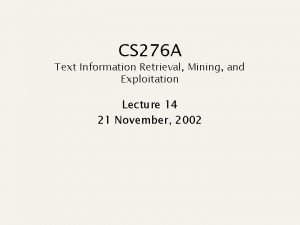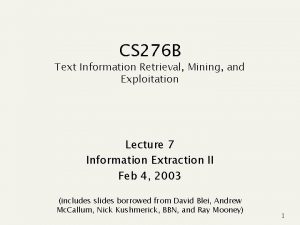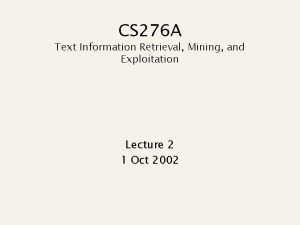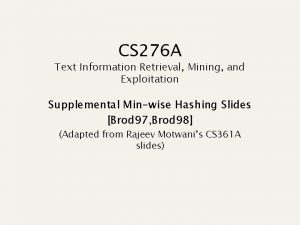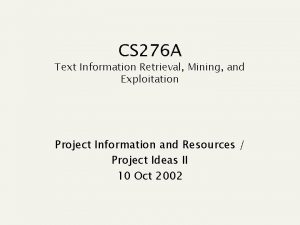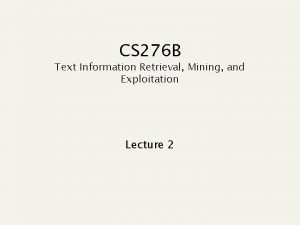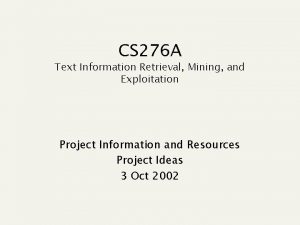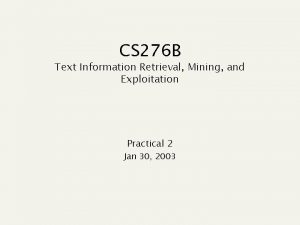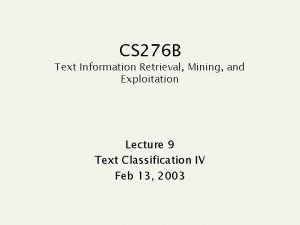CS 276 A Text Information Retrieval Mining and



































- Slides: 35

CS 276 A Text Information Retrieval, Mining, and Exploitation Lecture 7 24 Oct 2002

Standard Probabilistic IR Information need d 1 matching query d 2 … dn document collection

IR based on LM Information need d 1 generation d 2 query One night in a hotel, I saw this late night talk show where Sergey Brin popped on suggesting the web search tip that you should think of some words that would likely appear on pages that would answer your question and use those as your search terms – let’s exploit that idea! … … n dn document collection

Formal Language (Model) n Traditional generative model: generates strings n n Finite state machines or regular grammars, etc. Example: I wish I wish I wish … *wish I wish

Stochastic Language Models n Models probability of generating strings in the language (commonly all strings over ∑) Model M 0. 2 the 0. 1 a 0. 01 man 0. 01 woman 0. 03 said 0. 02 likes … the man likes the woman 0. 2 0. 01 0. 02 0. 01 multiply P(s | M) = 0. 00000008

Stochastic Language Models n Model probability of generating any string Model M 1 0. 2 0. 01 Model M 2 the 0. 2 the class 0. 0001 sayst 0. 03 0. 0001 pleaseth 0. 02 0. 0001 yon 0. 1 0. 2 pleaseth 0. 2 yon 0. 0005 maiden 0. 01 0. 0001 woman sayst the class pleaseth 0. 01 0. 0001 0. 02 yon maiden 0. 0001 0. 0005 0. 1 0. 01 P(s|M 2) > P(s|M 1)

Stochastic Language Models n A statistical model for generating text n Probability distribution over strings in a given language M P( |M) =P( |M) P( | M, ) ) )

Unigram and higher-order models P( ) =P( n n n ) P( | Unigram Language Models P( )P( )P( | ) Easy. Effective! ) Bigram (generally, n-gram) Language Models P( )P( | )P( Other Language Models n | )P( | Grammar-based models (PCFGs), etc. n Probably not the first thing to try in IR )

Using Language Models in IR n n n Treat each document as the basis for a model (e. g. , unigram sufficient statistics) Rank document d based on P(d | q) = P(q | d) x P(d) / P(q) n n P(q) is the same for all documents, so ignore P(d) [the prior] is often treated as the same for all d n n n But we could use criteria like authority, length, genre P(q | d) is the probability of q given d’s model Very general formal approach

The fundamental problem of LMs n Usually we don’t know the model M n But have a sample of text representative of that model P( n n |M( )) Estimate a language model from a sample Then compute the observation probability M

Language Models for IR n Language Modeling Approaches n n Attempt to model query generation process Documents are ranked by the probability that a query would be observed as a random sample from the respective document model n Multivariate approach n Multinomial approach

Retrieval based on probabilistic LM n n Treat the generation of queries as a random process. Approach n n Infer a language model for each document. Estimate the probability of generating the query according to each of these models. Rank the documents according to these probabilities. Usually a unigram estimate of words is used n Some work on bigrams, paralleling van Rijsbergen

Retrieval based on probabilistic LM n Intuition n Users … n n n Have a reasonable idea of terms that are likely to occur in documents of interest. They will choose query terms that distinguish these documents from others in the collection. Collection statistics … n n Are integral parts of the language model. Are not used heuristically as in many other approaches. n In theory. In practice, there’s usually some wiggle room for empirically set parameters

Query generation probability (1) n n Ranking formula The probability of producing the query given the language model of document d using MLE is: Unigram assumption: Given a particular language model, the query terms occur independently : language model of document d : raw tf of term t in document d : total number of tokens in document d

Insufficient data n Zero probability n n May not wish to assign a probability of zero to a document that is missing one or more of the query terms [gives conjunction semantics] General pproach n n A non-occurring term is possible, but no more likely than would be expected by chance in the collection. If , : raw count of term t in the collection : raw collection size(total number of tokens in the collection)

Insufficient data n There’s a wide space of approaches to smoothing probability distributions to deal with this problem, such as adding 1, ½ or to counts, Dirichlet priors, discounting, and interpolation n n [See FSNLP ch. 6 or CS 224 N if you want more] A simple idea that works well in practice is to use a mixture between the document multinomial and the collection multinomial distribution

Mixture model n n n P(w) = Pmle(w|Md) + (1 – )Pmle(w|Mc) Mixes the probability from the document with the general collection frequency of the word. Correctly setting is very important A high value of lambda makes the search “conjunctive-like” – suitable for short queries A low value is more suitable for long queries Can tune to optimize performance n Perhaps make it dependent on document size (cf. Dirichlet prior or Witten-Bell smoothing)

Basic mixture model summary n General formulation of the LM for IR general language model individual-document model n n The user has a document in mind, and generates the query from this document. The equation represents the probability that the document that the user had in mind was in fact this one.

Example n Document collection (2 documents) n n Model: MLE unigram from documents; = ½ Query: revenue down n d 1: Xerox reports a profit but revenue is down d 2: Lucent narrows quarter loss but revenue decreases further P(Q|d 1) = [(1/8 + 2/16)/2] x [(1/8 + 1/16)/2] = 1/8 x 3/32 = 3/256 P(Q|d 2) = [(1/8 + 2/16)/2] x [(0 + 1/16)/2] = 1/8 x 1/32 = 1/256 Ranking: d 1 > d 2

Ponte and Croft Experiments n Data n TREC topics 202 -250 on TREC disks 2 and 3 n n Natural language queries consisting of one sentence each TREC topics 51 -100 on TREC disk 3 using the concept fields n Lists of good terms <num>Number: 054 <dom>Domain: International Economics <title>Topic: Satellite Launch Contracts <desc>Description: … </desc> <con>Concept(s): 1. Contract, agreement 2. Launch vehicle, rocket, payload, satellite 3. Launch services, … </con>

Precision/recall results 202250

Precision/recall results 51 -100

LM vs. Prob. Model for IR n n The main difference is whether “Relevance” figures explicitly in the model or not Problems in LM approach n n Relevance feedback is difficult to integrate into the LM approach As are user preferences, and other general issues of relevance Can’t easily accommodate phrases, passages, Boolean operators Current extensions focus on putting relevance back into the model, etc.

Extensions: 3 -level model n 3 -level model 1. 2. 3. n Whole collection model ( ) Specific-topic model; relevant-documents model ( ) Individual-document model ( ) Relevance hypothesis n n A request(query; topic) is generated from a specifictopic model { , }. Iff a document is relevant to the topic, the same model will apply to the document. n n It will replace part of the individual-document model in explaining the document. The probability of relevance of a document n n The probability that this model explains part of the document The probability that the { , , } combination is

3 -level model Information need d 1 d 2 generation … … … query dn document collection

Alternative Models of Text Generation Searcher Query Model Query Is this the same model? Writer Doc Model Doc

Retrieval Using Language Models Query Model 1 3 Doc 2 Doc Model Retrieval: Query likelihood (1), Document likelihood (2), Model comparison (3)

Query Likelihood n n P(Q|Dm) Major issue is estimating document model n n Good retrieval results n n i. e. smoothing techniques instead of tf. idf weights e. g. UMass, BBN, Twente, CMU Problems dealing with relevance feedback, query expansion, structured queries

Document Likelihood n Rank by likelihood ratio P(D|R)/P(D|NR) n treat as a generation problem n n Issue is estimation of query model n n P(w|R) is estimated by P(w|Qm) Qm is the query or relevance model P(w|NR) is estimated by collection probabilities P(w) Treat query as generated by mixture of topic and background Estimate relevance model from related documents (query expansion) Relevance feedback is easily incorporated Good retrieval results n n e. g. UMass at SIGIR 01 inconsistent with heterogeneous document collections

Model Comparison n n Estimate query and document models and compare Obvious measure is KL divergence D(Qm||Dm) n n More general risk minimization framework has been proposed n n equivalent to query-likelihood approach if simple empirical distribution used for query model Zhai and Lafferty 2001 Better results than query-likelihood or document-likelihood approaches

Other Approaches n n HMMs (BBN) – really just a renaming of the mixture model present earlier Probabilistic Latent Semantic Indexing (Hofmann) n n assume documents are generated by a mixture of “aspect” models estimation more difficult probabilistic foundations questionable Translation model (Berger and Lafferty) n Lets you generate query words not in document via “translation” to synonyms etc.

Language models: pro & con n Novel way of looking at the problem of text retrieval based on probabilistic language modeling n n Conceptually simple and explanatory Formal mathematical model Natural use of collection statistics, not heuristics (almost…) LMs provide effective retrieval and can be improved to the extent that the following conditions can be met n n Our language models are accurate representations of the data. Users have some sense of term distribution. * n *Or we get more sophisticated with translation model

Comparison With Vector Space n There’s some relation to traditional tf. idf models: n n n (unscaled) term frequency is directly in model the probabilities do length normalization of term frequencies the effect of doing a mixture with overall collection frequencies is a little like idf: terms rare in the general collection but common in some documents will have a greater influence on the ranking

Comparison With Vector Space n Similar in some ways n n n Term weights based on frequency Terms often used as if they were independent Inverse document/collection frequency used Some form of length normalization useful Different in others n Based on probability rather than similarity n n Intuitions are probabilistic rather than geometric Details of use of document length and term, document, and collection frequency differ

Resources J. M. Ponte and W. B. Croft. 1998. A language modelling approach to information retrieval. In SIGIR 21. D. Hiemstra. 1998. A linguistically motivated probabilistic model of information retrieval. ECDL 2, pp. 569– 584. A. Berger and J. Lafferty. 1999. Information retrieval as statistical translation. SIGIR 22, pp. 222– 229. D. R. H. Miller, T. Leek, and R. M. Schwartz. 1999. A hidden Markov model information retrieval system. SIGIR 22, pp. 214– 221. [Several relevant newer papers at SIGIR 23– 25, 2000– 2002. ] Workshop on Language Modeling and Information Retrieval, CMU 2001. http: //la. lti. cs. cmu. edu/callan/Workshops/lmir 01/. The Lemur Toolkit for Language Modeling and Information Retrieval. http: //www-2. cs. cmu. edu/~lemur/. CMU/Umass LM and IR system in C(++), currently actively developed.
 Text and web mining
Text and web mining Text operations in information retrieval
Text operations in information retrieval Making connections
Making connections Text analytics and text mining
Text analytics and text mining Text analytics and text mining
Text analytics and text mining Difference between strip mining and open pit mining
Difference between strip mining and open pit mining Precision and recall in information retrieval
Precision and recall in information retrieval Information retrieval and web search
Information retrieval and web search Information retrieval data structures and algorithms
Information retrieval data structures and algorithms Examples of information retrieval tools
Examples of information retrieval tools Information retrieval data structures and algorithms
Information retrieval data structures and algorithms Strip mining vs open pit mining
Strip mining vs open pit mining Chapter 13 mineral resources and mining worksheet answers
Chapter 13 mineral resources and mining worksheet answers Multimedia data mining
Multimedia data mining Mining complex data types
Mining complex data types Text based image retrieval
Text based image retrieval Text retrieval software
Text retrieval software Sequential searching
Sequential searching Information retrieval architecture
Information retrieval architecture Query operations in information retrieval
Query operations in information retrieval Recall skip pointers: what is skip span?
Recall skip pointers: what is skip span? Index construction in information retrieval
Index construction in information retrieval Index construction in information retrieval
Index construction in information retrieval Which internet service is used for information retrieval
Which internet service is used for information retrieval Information retrieval tutorial
Information retrieval tutorial Wildcard queries in information retrieval
Wildcard queries in information retrieval Capabilities of information retrieval system
Capabilities of information retrieval system Link analysis in information retrieval
Link analysis in information retrieval Information retrieval lmu
Information retrieval lmu Defense acquisition management information retrieval
Defense acquisition management information retrieval Advantages of information retrieval system
Advantages of information retrieval system Information retrieval nlp
Information retrieval nlp Information retrieval slides
Information retrieval slides Relevance information retrieval
Relevance information retrieval Information retrieval stanford
Information retrieval stanford Link analysis in information retrieval
Link analysis in information retrieval

